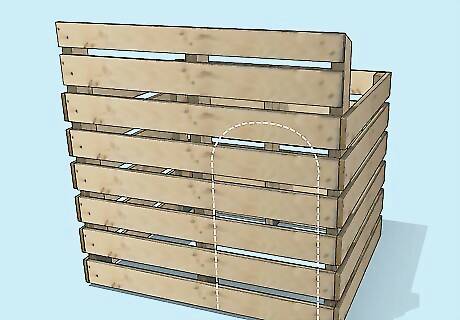
views
Planning the Pallet Dog House

Gather 3 stringer pallets for the dog house. For this guide, you’ll be building an average-sized doghouse at 40 inches (100 cm) long, 32 inches (81 cm) wide, and 28 inches (71 cm) tall at the top of the slanted roof—big enough for medium and large-sized pups. Check with local retail stores to see if they have free pallets, and ask around at construction sites and bars. Three average-sized pallets (48 inches (120 cm) by 40 inches (100 cm)) are sufficient make your doghouse, but feel free to grab more if you want a little extra wood. A "close-boarded" pallet means there are no spaces between the wooden deck boards, and "stringer" (or alternatively, "2-way") means that only 2 sides are open; the others are held together with thicker wooden stringer boards. A dog house should have enough space to enter the house and turn around. If you have an extra-large dog, build a house that is 25% taller than them and wide enough for them to lay down with 2 inches (5.1 cm) of space on either side.

Find a shady spot in your yard to place the dog house. Shade extends the life of the dog house and keeps your dog cool on hot days. If possible, set the dog house up against a wall—either your house or a garage—to shield it from the wind. Pay attention to the weather on windy days, so you know which direction the wind most often comes from, and make sure the back of the dog house is facing that direction.

Even out the ground to ensure the dog house sits flat. Dirt is the most common ground to place a dog house onto; dig up weeds with a trowel or shovel and the backside of a rake to spread the soil around and even it out. Ensure that the ground is entirely clear of grass and as flat as possible. Lay down a third pallet (in its original form, no alterations) and place the dog house on top; this gives the house a foundation and protects it from hot, cold, or wet ground.
Dismantling and Cutting the Pallets

Remove a single side from 2 pallets and take the third apart entirely. Using a hammer and crowbar, pry up the nails holding each board in place. Wedge the tip of the crowbar between the pallet deck board and stringer (the long piece holding all the thinner boards in place) and then hammer it deeper in so you can pry the board up. Continue doing this on each end and the middle of the board before gently removing it from the pallet. This way, you'll have 2 pallet sides with the planks and stringer boards intact for the front and back walls, plus a large pile of loose pallet planks for building the side walls.

Split the intact side of the pallets to get the front and back walls. Since your pallet boards are roughly 3.5 inches (8.9 cm) wide, make the front wall 8 horizontal panels high, and the back wall 6 horizontal boards tall. Saw through the vertical stringers holding the pallet boards together with a jigsaw or hand saw. This means that the front wall will be 28 inches (71 cm) tall, and the back will be 21 inches (53 cm) tall.

Saw the boards you detached from the pallet to 32 inches (81 cm) each. Measure the correct length with a tape measure and mark it in pencil on each board before making your cuts with a hand saw. Make sure you have a dozen 32 in (81 cm) boards total, 6 for either side of the dog house.

Trim a sheet of plywood to create the floor of the house. Ensure that this piece of plywood matches the exact dimensions of the dog house's walls. The plywood floor of your dog house will be 40 inches (100 cm) by 32 inches (81 cm) so that it fits into the structure without any overlapping edges.

Measure and construct a plywood roof for the house. To protect the rest of the house from rain, cut the plywood 4 inches (10 cm) longer than the dimensions of the house. Since the walls are approximately 40 inches (100 cm) by 32 inches (81 cm), your roof will be one slanting piece of plywood measuring 44 inches (110 cm) by 36 inches (91 cm).
Assembling the Walls, Floor, and Ceiling

Join the front and back walls with 32 in (81 cm) side boards. Build the first side wall by standing your front and back walls upright on their sides and attaching a 32 in (81 cm) board between them. Hammer in 2 nails on both ends of the board, or use a nail gun to securely fasten it to each wall. Attach the following 5 panels the same way, and apply wood glue to the sides of each board as you go so that they're secured to one another. Use 24 1.25 in (3.2 cm) nails to attach the walls. Once you have a side wall built, do the same thing on the opposite side. Build up a wall by nailing and gluing boards one at a time until the wall is 6 horizontal boards high—the same height as the back wall. At this point, the walls should be secured, all of them the same height.

Trace and cut a door into the house's front wall with a jigsaw. Tailor the door to the size of your dog, as making the door too big could allow cold air inside the house and make your pup uncomfortable. In pencil, use a straight-edge to draw a doorway that is at least 6 inches (15 cm) wider than your dog and 6 inches (15 cm) taller than the dog’s body. Then, use your jigsaw to cut the entryway. Measure your pup's body beforehand, so you know how big they are! For a curved entryway, use a 5 US gal (19 L) bucket to trace a curved top of the door.

Attach the plywood floorboard to the walls of the house. Apply wood glue to the bottom of each wall before nailing on the floor. Then, stick the walls and floor together and start nailing from the bottom of the floor sheet into each house wall. Hammer in a 1 ⁄4 in (3.2 cm) nail on each corner, and a single nail in the middle of each wall. You'll need 8 nails total for this step.

Cover the roof with 15 lb (240 oz) tar paper. Since rain and other harsh weather can damage wood, the next step is making your roof a bit more rain-resistant. Cut a piece of 15 lb (240 oz) tar paper with the same dimensions and fix it to the roof with a staple gun and .375 in (0.95 cm) galvanized staples. That way, the rain will slide off rather than seeping into the wood and getting your pup all wet.

Nail a wood stopper to the roof to make it removable. Mark the spot where your plywood roof meets the inside of the dog house's back (shortest) wall. Then, grab a scrap piece of pallet wood that's shorter than the width of the wall. Lay it horizontally along the roof, parallel and right up against the markings, and nail it down firmly. When building the roof, use short ⁄4 in (1.9 cm) nails that won't poke through the wood. With an extra board nailed inside the roof, at the bottom of its slant, the roof will sit in place while your dog uses it—but you can also lift the roof off easily to clean inside.
Sanding, Staining or Painting, and Furnishing

Sand down the surface of the finished house. Because pallet wood is so cheap, it's also often rough and splinters easily. To keep your dog safe and comfortable, use a medium-grit sanding block to smooth out all of the house's rough edges. Follow up your initial sanding with a fine-grit sanding block to further smooth the pallet wood. You don't have to smooth the wood out completely if you don't want to. A single round of sanding is plenty, and your dog house will have a rustic look.

Paint or stain the house with a paint brush to give it a polished look. Stain the house with linseed oil as a non-toxic finish, or select any stain that is labeled as non-toxic and eco-friendly to ensure your furry friend's safety! If you paint your dog house, use water-based latex or acrylic paint. It's non-toxic and unlikely harm your dog if they accidentally ingest the paint. Painting or staining the wood gives your dog house a little personality. Pick whichever product fits the style you're going for! If you want to stain the wood, you'll also preserve the rustic look of the pallet wood. Meanwhile, applying paint will make the dog house wood look brand new.

Accessorize the house for your dog's comfort. Since weather can more easily ruin a blanket, try cushioning the dog house with either wood shavings, straw, or a moisture-proof foam pad. This will keep your dog comfy without attracting pests or getting ruined on a rainy day. Consider investing in a weather-proof water dish for your pup to drink from while resting outside. If you use wood shavings or straw for padding, change them weekly.




















Comments
0 comment